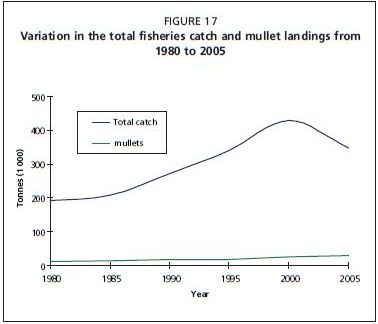ENVIRONMENTAL IMPACT OF MULLET SEED FISHERY
Although the collection of mullet seed in Egypt goes back many decades, there is no published scientific study on the impact of this activity on the wild stocks. Most of the available information is based on comparing mullet catches in relation to the recorded number of collected fry. The extrapolated results are of limited value as landing estimates are not accurate enough (e.g. illegal catches are excluded) to evaluate possible impacts of wild seed collection.
Figure 17 compares total fish landings in Egypt with the landings of mullets over a 25-year period and clearly indicates that mullet catches have not decreased. Based on these figures it seems that the
Figure 17
Variation in the total fisheries catch and mullet landings from 1980 to 2005

activity and fishers tend to know when the fishing grounds are likely to receive large volumes of mullet fry of each species. During these periods, fry of the target species are found in large shoals and, since the presence of unwanted species greatly reduces the market price of mullet seed, the fishers carefully inspect their catch and return unwanted fish species, if any, back to the sea.
The presence of other species with mullet seed was studied the mid-1980s (Kleijn, 1988). Kleijn (1988) showed that 87 percent of the collected seed (sample size 78 000 fry) were mullet, 6.9 percent ribbonfish (Lepidopus sp.), 3.1 percent silverside (Atherina sp.) and halfbeaks (Hemiramphus sp.) and 2.9 percent Gammarus sp.
Finally mullet seed fishing is carried out in shallow coastal waters on sandy and muddy substrates. The impact of the fishery on bottom biota has not been evaluated, however, the impact is likely to be minimum compared to impacts of fishing activities on other sensitive ecosystems (e.g. coral reefs).